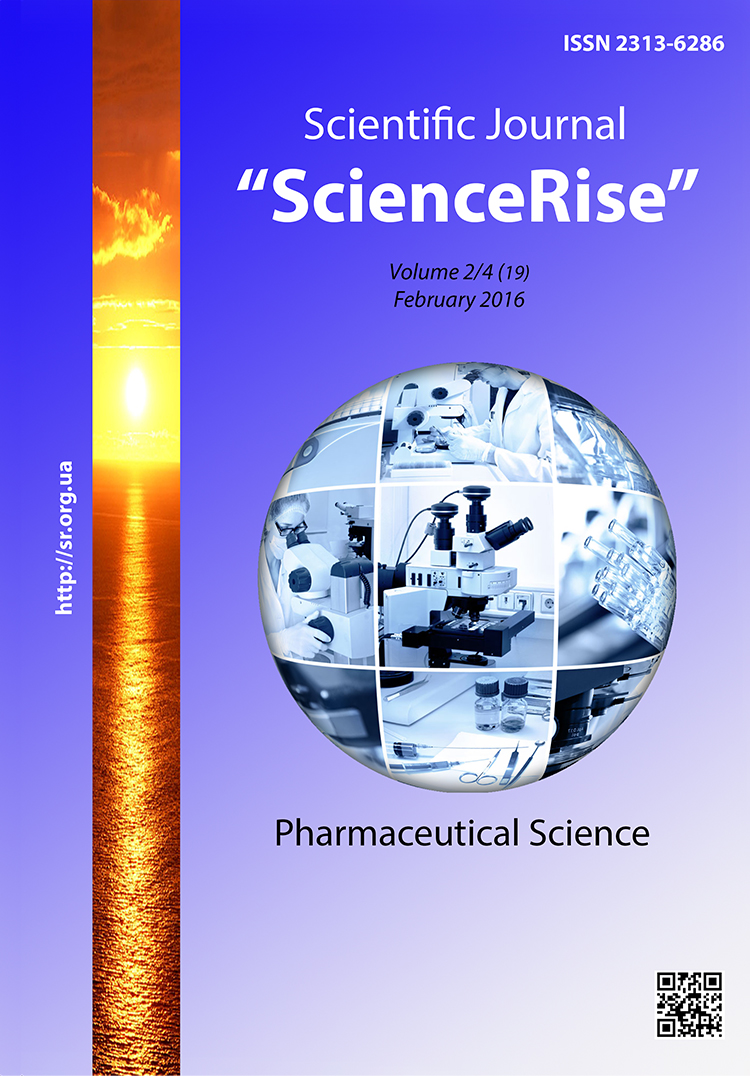Development of methods for determination of phenolic acids and flavonoids in capsules containing Corylus avellana L. Dry extract
DOI:
https://doi.org/10.15587/2313-8416.2016.61495Keywords:
capsules, Corylus avellana L., extract, HPTLC, absorption spectroscopy, phenolic acids, flavonoidsAbstract
The questions of standardization and quality control of both herbs and herbal remedies remain relevant, because it is well-known that product quality standards are essential, whether consumer using herbs or drugs. The necessity of the standardization methods development for the initial herbal material and capsule dosage form for the further quality control under manufacturing conditions remains relevant.
Aim. The aim of our research was to develop simple, specific, accurate and reproducible methods for identification of flavonoids and phenolic acids in capsule dosage form containing Corylus avellana L. dry extract.
Methods. The samples of gelatine capsules containing Corylus avellana L. dry extract for oral administration were analyzed. The analysis was carried out using Camag HPTLC system.
The absorption spectroscopy determination of the sum of flavonoids was carried out using THERMO Scientific Evolution 60S Spectroscope in wavelength range of 300–600 nm.
Results. As a result of HPTLC research rutine and quercitrine have been identified in capsule dosage form containing Corylus avellana L. dry extract. Among phenolic acids, neochlorogenic and chlorogenic acids have been identified.
Under the given conditions, the spectrum of the test solution had a maximum absorption at wavelength 406 nm. The analysis of flavonoids total content in gelatine capsules containing Corylus avellana L. dry extract calculated as rutine has shown the content of 1,7 %.
Conclusion. Effective HPTLC and absorption spectroscopy methods for determination of flavonoids and phenolic acids in capsule dosage form containing Corylus avellana L. dry extract have been developed. It has been found that described methods are promising enough for standardization of capsules with Corylus avellana L. dry extract and may be suggested for the quality control of the dosage form under manufacturing conditions
References
Bauer, R. (1998). Quality Criteria and Standardization of Phytopharmaceuticals: Can Acceptable Drug Standards be Achieved? Therapeutic Innovation & Regulatory Science, 32 (1), 101–110. doi: 10.1177/009286159803200114
Wani, M. (2007). Herbal medicine and its standardization. Pharmaceutical information, 1, 6.
Tsyvunin, V. V., Shtrygol’, S. Yu., Prokopenko, Yu. S., Toryanic, E. L. (2014). Experimental defining of anticonvulsant action of perspective phytogenic anticonvulsants. Ukrainian biopharmaceutical journal, 3 (32), 45–49.
Tsyvunin, V. V., Shtrygol’, S. Yu., Prokopenko, Yu. S., Geprgiyants, V. А. (2012). Screening research of the anticonvulsant action of dry extracts from 8 species of herbs members of the Solanaceae, Papaveraceae, Lamiaceae and Polemoniaceae families. Clinical pharmacy, 16 (4), 47–50.
Mishchenko, V. A. (2013). A targeted search of the anticonvulsant substances from herbs members of the Solanaceae family. Zaporizhzhya, 160.
Bluznyuk, N. A., Prokopenko, Yu. S., Geprgiyants, V. A. (2015). A comparative research of the flavonoids content in leaves of decorative shrubs – members of Ukrainian flora. Collection of scientific works of Shupyk NMA, 24 (4), 321–325.
Tistaert, C., Dejaegher, B., Heyden, Y. V. (2011). Chromatographic separation techniques and data handling methods for herbal fingerprints: A review. Analytica Chimica Acta, 690 (2), 148–161. doi: 10.1016/j.aca.2011.02.023
Attimarad, M., Mueen Ahmed, K. K., Aldhubaib, B. E., Harsha, S. (2011). High-performance thin layer chromatography: A powerful analytical technique in pharmaceutical drug discovery. Pharmaceutical Methods, 2 (2), 71–75. doi: 10.4103/2229-4708.84436
Sherma, J. (2010). Review of HPTLC in drug analysis: 1996–2009. Journal of AOAC International, 93 (3), 754–764.
Heyden, Y. V. (2008). Extracting information from chromatographic herbal fingerprints. LCGC Europe, 21 (9), 438–443.
Blatter, A., Reich, E. (2004). Qualitative and Quantitative HPTLC Methods for Quality Control of Stephania tetrandra . Journal of Liquid Chromatography & Related Technologies, 27 (13), 2087–2100. doi: 10.1081/jlc-120039420
Fang, C., Wan, X., Jiang, C., Cao, H. (2005). Comparison of HPTLC and HPLC for determination of isoflavonoids in several kudzu samples. Journal of Planar Chromatography – Modern TLC, 18 (101), 73–77. doi: 10.1556/jpc.18.2005.1.13
Spangenberg, B., Poole, C., Weins, C. (2011). Quantitative thin-layer chromatography: a practical survey. Berlin: Springer, 373. doi: 10.1007/978-3-642-10729-0
Selivanchikova, I. B., Lyakina, M. N., Kostennikova, Z. P. (2001). A quantitative determination of flavonoids in gomeopathic Thuja tinctures by the absorption spectroscopy method. Pharmacy, 6, 14–16.
Downloads
Published
Issue
Section
License
Copyright (c) 2016 Nataliya Blyznyuk, Yuliya Prokopenko, Victoriya Georgiyants

This work is licensed under a Creative Commons Attribution 4.0 International License.
Our journal abides by the Creative Commons CC BY copyright rights and permissions for open access journals.
Authors, who are published in this journal, agree to the following conditions:
1. The authors reserve the right to authorship of the work and pass the first publication right of this work to the journal under the terms of a Creative Commons CC BY, which allows others to freely distribute the published research with the obligatory reference to the authors of the original work and the first publication of the work in this journal.
2. The authors have the right to conclude separate supplement agreements that relate to non-exclusive work distribution in the form in which it has been published by the journal (for example, to upload the work to the online storage of the journal or publish it as part of a monograph), provided that the reference to the first publication of the work in this journal is included.

